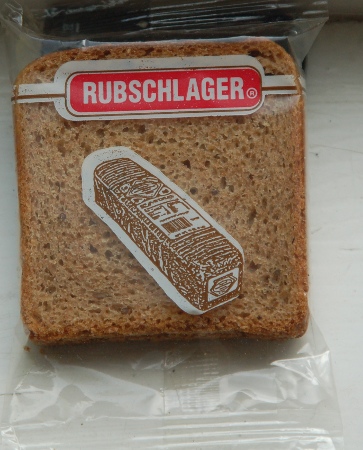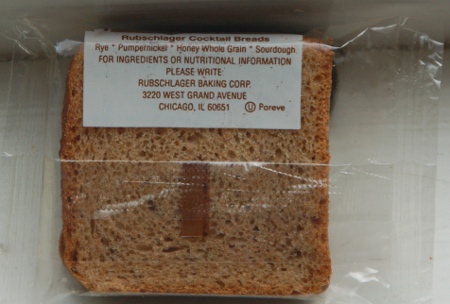I was just in the US, something I posted about earlier. Somehow, I always seem to end up on United, and I’m often not very impressed with their food, but it’s really gotten very bad lately.
Vegetarian Food
I don’t eat meat, and you would think a vegetarian meal would be possible on a flight with meal service. Especially on United, since almost every flight I’ve been on in the last several years has offered two main entrees, one of which was vegetarian. Usually the stewardesses can be found working the isles during food service, saying ‘pasta or chicken?’ to each passenger in turn.
The problem of course is that they tend to run out of vegetarian meals first, and if you are a vegetarian seated in the back of the plane, you may end up without a meal if you don’t make arrangements in advance. You have to ask yourself why, if they often run out of vegetarian meals first so often, they can’t stock more of them to begin with? For whatever reason this doesn’t seem possible.
I remember flying as a kid, and getting a vegetarian meal reserved on the spot by just asking a stewardess to set one aside for me, but for whatever reason they don’t do that anymore.
To be assured of a vegetarian meal on United, you have to book this at least a few days in advance, and you have to specify exactly what sort of vegetarian meal you want. You have to choose between things like a diabetic meal, a Halal (Muslim) meal, a western vegetarian, a vegan meal, a lacto-ovo meal, an Asian vegetarian meal, and so on. Even at this stage, it’s not possible to order a ‘normal’ — what everyone else gets — vegetarian meal. For what it’s worth, I usually end up choosing Asian vegetarian, and it’s usually Indian food of some sort. Other choices usually end up being a very dry, tasteless and processed vegan meal, or perhaps one that’s nothing but cheese and eggs.
Processed Foods
In the past these special meals on United used to be of pretty good quality. It’s always an issue that they tend to apply dietary restrictions above and beyond what you stated, for example insisting vegetarians must eat margarine with their bread, even though many like me would prefer butter as it’s a more natural food. Nevertheless, these kinds of things are small issues, and considering how difficult it can be to cater to everyone’s dietary needs, I don’t need to be too picky.
The real problem now however, is these special meals tend to be almost all highly processed foods, intended for long storage, emphasizing high fructose corn syrup (HFCS). I can’t say anything about the regular meals, because I don’t get a chance to eat them, but the special meals no longer have any fresh or ‘local’ ingredients at all. If there’s fruit, it’s canned fruit. The only exception might be a little iceberg lettuce in a salad. It’s always necessary to read the ingredients on label of all the foods, to make sure you aren’t eating total crap, especially if you want to avoid HFCS.
Considering all the places United flies, it really makes you wonder why they can’t source a little true local food, or at least something fresh from time to time.
For the beverage service too, it’s nearly all based on HFCS. If you don’t want something to drink with HFCS, it’ll probably be alcoholic, water, milk or orange juice. This is not really a selection most people would consider acceptable. Especially since orange juice itself is very processed, and known to contain an unusually high level of pesticides on average, when compared to other foods and drinks.
Reading the Labels
Some of the common things in United meals are just a total mix of crap. For example their vinaigrette must be reduced fat or something, and the ingredients are just a long list of chemicals. Many things are not labelled! For example, the jams and jellies are not labelled, and have the distinctive taste of HFCS.
The breads tend to be really processed and come in little plastic packages.
There was a bread on my outgoing flight with a Dutch sounding name that I forgot, that supposedly comes from Holland, but it’s made with HFCS. While some foods are made with HFCS here, it goes by different names like glucose-fructose syrup, so it’s unlikely to truly be a Dutch food if it has HFCS and is labelled as such. In any case, it wasn’t a name I recognized.
Here’s a bread that was served on my return flight:

This picture makes it look big, but this was really a small cocktail sized piece of bread, about 2″ or 5cm on a side.
And the ingredients label on the back?

So, does Rubschlager or United Airlines really think someone who ordered a special meal, is obviously concerned about and trying to figure out what they are eating, is really going to want to write them a letter while 39000 feet in the air travelling across the Atlantic? Even if I did write them a letter, I would still never know what I ate or could of ate, because they have a number of different lines of breads and this one isn’t labelled as to which one it is. I suppose if I write them, I’ll have to send them their piece of bread back, so they can make a visual inspection.
Even on their website, they don’t list the ingredients.
There is virtually no country in the world where it’s legal to sell unlabelled food like this, it’s only because United serves this in international airspace that they can get away with it.
The Entree
So besides excessively processed breads, jams and canned fruit, what comes in a specially ordered meal on United?
I ordered an Asian vegetarian meal, and on my outbound flight the main entree was a serving of cooked white rice and a serving of peas next to it. No sauce, no spices, absolutely nothing besides rice and peas. It also had a totally inedible salad, with equally totally inedible dressing and a half canned peach.
The return flight was a little better. In this case there was a very small serving of Saag Paneer, with a few pieces of cheese as well as a small serving of vegetable curry. It also came with a serving of yoghurt, It was not terribly exciting, but not that bad. What was funny however was, a few hours later when the snack was served, they decided at that point I couldn’t eat dairy products. Since the regular snack came with butter and a serving of yoghurt, instead they served me something different with margarine and apple sauce.
Message to United
Your meal service is a disaster.
In an age where people increasing expect to eat freshly prepared food, and the dangers of eating HFCS are becoming more well known, you are serving processed crap full of HFCS. You don’t even offer a realistic possibility for people to avoid HFCS if they want to.
Would it really kill you to offer a fresh piece of fruit instead of a half a canned peach?
Why don’t you honestly label the foods you serve, or better yet serve unprocessed foods that don’t need to be labelled?
Even on your domestic flights, where you offer meal boxes for sale, you only offer processed foods full of chemicals. What you offer is also not very suitable for vegetarians.
How about charging us $5 more when we book our flights, and invest this in improving the meal service?
How about making possible for vegetarians to reliably make use of the standard vegetarian meal option, if this turns out to be the best alternative?




